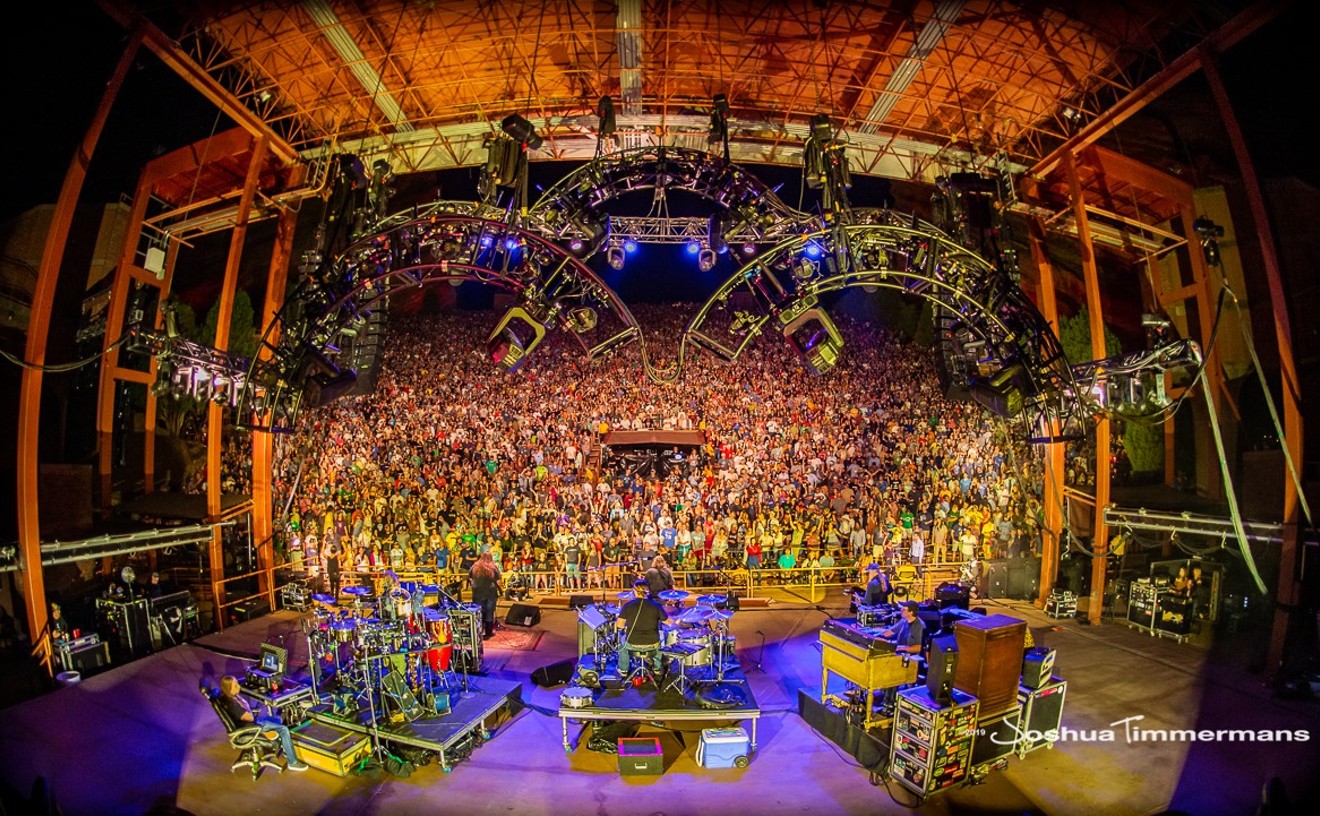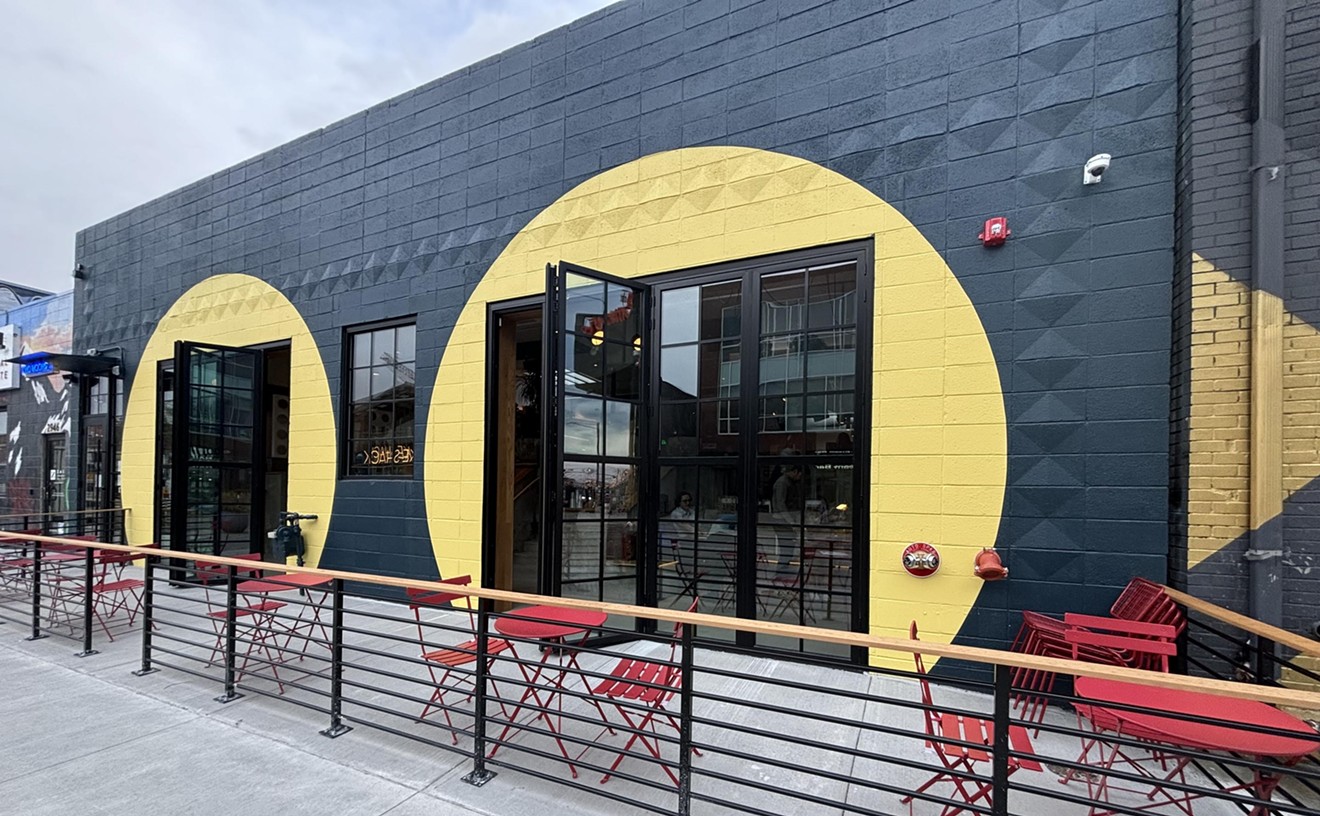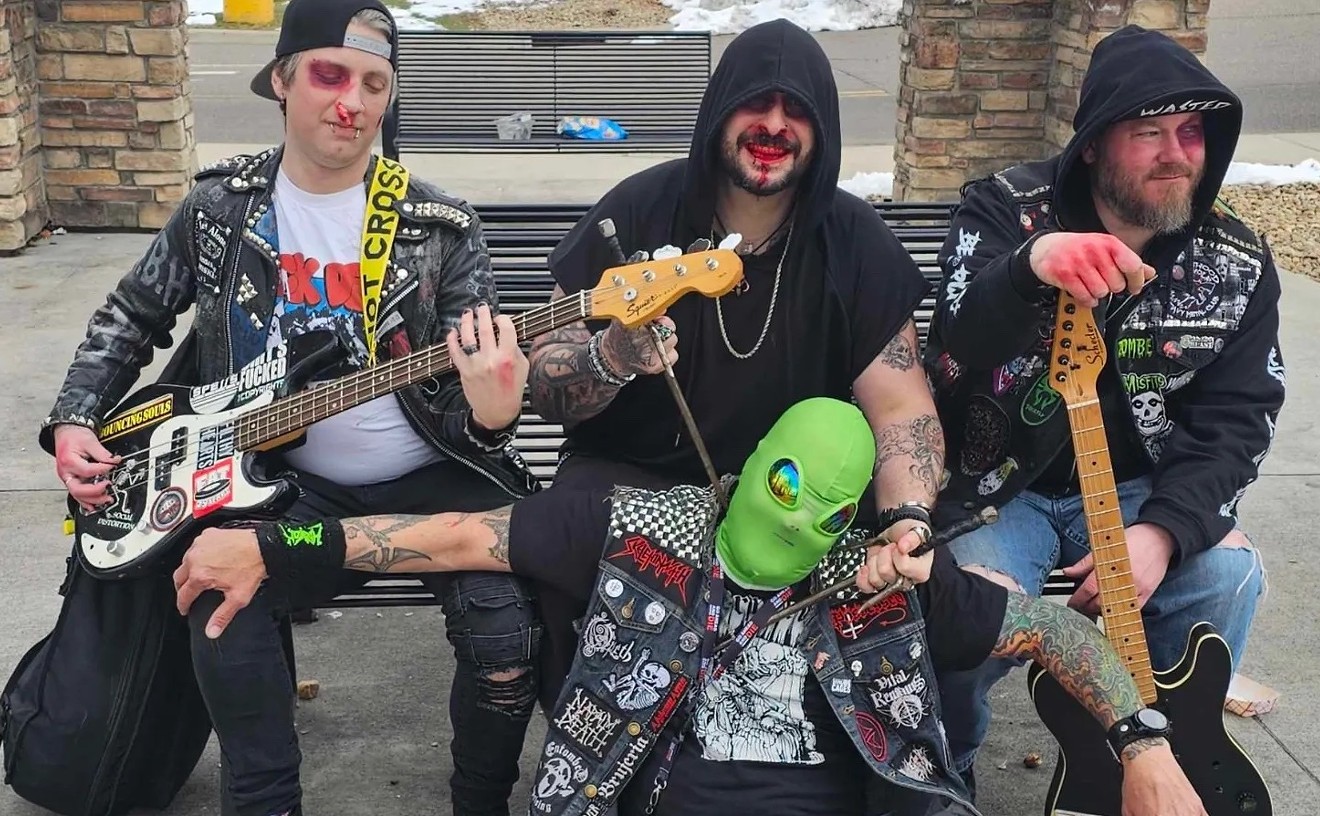The thirty-something McFadyen, who uses London as his home base, is hard to miss. He's among the most immediately recognizable figures on the current dance scene, thanks to his hairstyle, which seems to feature half the dreadlocks in Jamaica, and a fondness for shades that are only slightly smaller than a Miata's windshield. Such flamboyance comes naturally, since McFadyen considers himself to be a music-maker first and a DJ second -- and Bring Me the Head of Freq Nasty, a thoroughly entertaining full-length produced for Skint Records, backs up this belief. Tracks such as "Come Let Me Know," co-starring MC Rodney P, may be compulsively danceable, but they're more than mere grooves. Rather, they're actual songs designed by McFadyen with the CD format in mind.
"Making an album gives me more scope," he notes. "The dance-floor aesthetic is great, because it's very functional. When I'm making club tunes, I work on a sonic level that makes people dance, and I enjoy the simplicity of that. But it's nice to work on an album, where you don't have to focus on just those functional aspects. It gives you more colors to work with."
Not that McFadyen feels handcuffed by having to operate within the constraints of the dance medium. "The word 'limiting' can be sort of deceptive," he maintains. "Think about a Renaissance master painter who could only paint in two dimensions. If you look at things in terms of what we can do today with film and 3-D animation, you might think the painter was limited. But the parameters only made those painters better. You have a certain palette, and when you twist that up in ever more subtle ways, it's still very creative. You might even say the limitations force you to become more creative."
A native of Fiji who moved with his family to New Zealand when he was a toddler, McFadyen developed a love of music with a little help from his father, an accomplished guitarist. After studying the drums during his early teens, McFadyen added his dad's instrument of choice to his repertoire; he soon found himself in a cover combo specializing in "stuff by Eric Clapton right through to Duran Duran and things in the '80s." Only after borrowing a primitive sampler from the group's keyboard player did he begin to find his own musical voice.
"He just used it for strings and horns and things like that," McFadyen recalls. "But I was listening to a lot of hip-hop at the time, and even though it had a very tiny amount of sampling time on it, I'd spend my weekends trying to work out how Public Enemy made all those sounds on their records." After a year or so of fiddling about, he purchased his own sampler and realized that "I could make up my own tunes. And from then on, it was open season."
Unfortunately, the local scene didn't provide a lot of opportunities for a budding beat-master. "Now, New Zealand is amazing," he allows. "There's so much good stuff: hip-hop, reggae, deep house music, and breaks as well. But back then, it was mostly just shitty pub-rock music." For that reason, McFadyen relocated to Australia before landing in London shortly after the dawn of the '90s. He soon immersed himself in breakbeat, a nascent movement that took the spare feel of drum-and-bass and upped its accessibility for club consumption. Breakbeat pioneer Gervase Cooke, aka B.L.I.M., was a kindred spirit, and in 1995, a collaborative effort they dubbed "Jeamland" made waves in England and beyond. McFadyen's profile rose as a result, and he soon found himself awash in offers to man the control boards at assorted venues. "I kept telling them, 'I'm not a DJ. I'm not a DJ,'" he points out. "But after a while, I thought, I might as well."
Before long, he learned that such gigs aren't as easy as they might seem to the uninitiated. "I just jumped into the deep end," he says. "Making records is the fast track to getting good DJ gigs, so all of a sudden, I was deejaying with people who'd spent ten years slowly building up to where they could play the good clubs in London, because they hadn't been making records. I was dropped in beside them, and I couldn't deejay at all. I was terrible when I started, so I had to learn very, very quickly."
As his skills developed, he became a sought-after mixologist. Long before the release of 2002's Y4K: Next Level Breaks, a well-regarded comp issued under his name, he was chosen to remix cuts like "Sound of Da Police," by KRS-One. His approach to this assignment was to "keep it simple and let the vocal shine. It's a classic tune, so for me, the job was just to give the beats a new spin, speed them up to the tempo of my genre, and let the essence of the vocal come through. I wouldn't have wanted to use a tiny little loop and a few little noises."
He wasn't nearly as circumspect when it came time for him and B.L.I.M. to tinker with "Desert Music," by minimalist composer Steve Reich, for the 1999 platter Reich Remixed. "I wasn't very aware of who he was when they asked us to do it," McFadyen concedes. "All of these other people, like Andrea Parker and Coldcut, were a lot more familiar with him, so most of them left the basic tracks exactly the same and then added a few more beats to give it more of a clubby feel. But B.L.I.M. and I sampled the fuck out of it, chopped it into a million pieces and made a tearin' dancehall tune out of it. Then, after we were done, I read his blurb and thought, 'Fuck -- I hope he likes it,' because we'd really mashed up his tune. And he did. He was at this party for the launch of the album, and he was impressed that we were the only ones who weren't cowed by his reputation."
In the meantime, McFadyen wrote and recorded the songs that landed on his first CD, 1999's Freqs, Geeks & Mutilations. Throughout it, he took full advantage of every gizmo in his arsenal even as he tried to put a personal stamp on each track. "You've got to figure out how much of yourself you can put into the music," he states. "When I hear people doing stuff that's kind of cliched or where they're not really trying, it doesn't sound like anything to me other than the technology. But when I hear something by people who are taking it to the next level, I can tell exactly who's doing it within five seconds of hearing it, even if they're using the exact same machines. That's what makes the difference to me."
For the recordings that became Head, McFadyen put a diverse range of music on the table. "It was a conscious decision," he confirms. "I really wanted to give people more of a varied listening experience because, after all, it is an album, and it gives you a chance to open up more, and in a way, I suppose, lets you wear some of your influences on your sleeve. So I sat down and said, 'Who would I like to work with?' -- and I was very lucky."
Guest stars on Head include rapper Kovas, who propels "Brooklyn 2 Brixton," and Junior Delgado, a longtime Lee Perry associate who puts plenty of reggae authenticity into the concluding "Mad Situation." McFadyen also reached out to fellow Brit Rodney Smith, who performs under the handle Roots Manuva. "Boomba Clat," which pairs Smith with vocalist Yolanda, is Head's most elaborate production, replete with wild rhythms and a brass section that's the genuine item, not a synthesized replication.
Tracks that find McFadyen flying solo are just as eclectic. Take "La Machina Latina," the CD's most deceptively idiosyncratic mélange. "To me, it has a kind of Latin-y vibe," he says, "but I didn't want to do straight Latin, with Latin percussion and all of that. So I used electronic stuff sort of like Black Dog -- and since a dancehall thing runs through the album to a certain extent, I melded that in, too. So you've got weird electronics with a Latin riff over the top of a dancehall beat."
Such a complex blend may be lost on club-goers, which is why McFadyen generally keeps things more basic during DJ sessions. But that doesn't mean he's apt to fade into the woodwork.
"Today, people don't want to see some faceless guy standing behind the decks 300 yards away with his head down, twiddling knobs," he says. "They want a combination of the rave spirit with more focus, more artist energy and enthusiasm. And that's what I try to give them."











